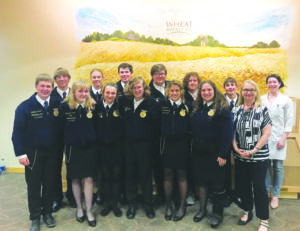
Dr. Jayne Bock – Technical Director of the Wheat Marketing Center.
The National FFA Organization plays a large role in the lives of students across the State of Montana. This program first started in 1928 and has since spread across all 50 states and five territories. Chartered in 1930, the Montana Association has a membership of over 5000 students, in 99 chapters spread across the state. The FFA Motto is “Learning to Do, Doing to Learn, Earning to Live, Living to Serve” and members practice this every day. Students have boundless opportunities to learn about potential careers, serve their communities, and develop skills that will last a lifetime.
One unique opportunity that took place recently was the Agriculture Commodity Tour. Students travelled by van over 1750 miles, visiting Idaho, Oregon and Washington, stopping at various locations along the way. The State Officer Team as well as the Agronomy Team from Stevensville hit the road on August 7th, led by State Advisor Jim Rose, State Foundation employee Katherine Taylor and Stevensville FFA Advisor Josette Hackett.
The first stop on the trip was at the Port of Lewiston in Lewiston, Idaho where the group took a tour of their facilities. Members found it interesting to see the transport of grain on such a large scale. As agriculturalists, students felt it was important to understand what happens to our Montana grain after it is harvested. The tour of the Port gave us a unique perspective and new respect for what goes on behind the scene
Rose is a big advocate of the Agriculture Commodity Tour and has seen the great impact it has on students. The exposure to Agriculture on an international scale is kind of an eye-opening experience. One of the highlights of the trip is visiting the Wheat Marketing Center in Portland, Oregon. The Wheat Marketing Center (WMC) is one of the technical crossroads of the international wheat industry, providing technical training and grower workshops, innovative research, product development, and crop quality testing services. WMC focuses on promoting U.S. wheat by demonstrating its quality and functionality in Asian noodles, crackers and biscuits, tortillas and flatbread, and other baked products. Very few people get the privilege to get a behind-the-scenes look in the Wheat Marketing Center.
Another interesting stop was made at Shaver Transportation. This business provides barges and tug boats to move a variety of commodities up and down the Columbia River System. Attendees got the opportunity to take a mile-long ride on a tug boat on the Willamette River.
Another highlight of this year’s trip was visiting Three-Mile Canyon Farms. This 93,000-acre farm produces a variety of crops but the most notable product they produce is milk. They milk 35,000 head of cattle twice a day which yields almost 2 million lbs. of milk each day. They have 386 center pivots across the farm and irrigate almost 40,000 acres. Also, during the five-day trip the students visited Bonneville Dam and fish hatchery, Rocky Mountain Elk Foundation and Multnomah Falls.
This experience was generously sponsored by Columbia Grain, the Montana Wheat and Barley Committee and the Idaho Forest Group.